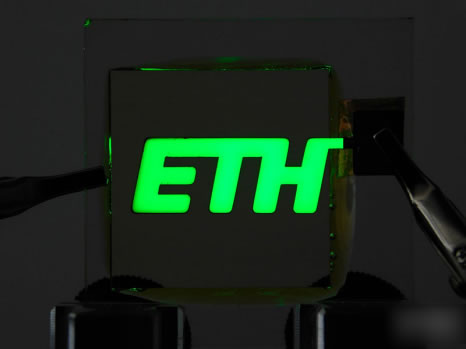Researchers at the Chemical Engineering Laboratory of the Federal Institute of Technology in Zurich recently invented an ultra-thin flexible light-emitting diode (LED) that emits ultra-pure green light. The researchers used this fine tone to display the three letters “ETHâ€. ". Professor Chih-Jen Shih, head of the research team, was very satisfied with his research breakthrough: “So far, no one has succeeded in producing a pure green light like ours.â€

Professor Shih pointed out that the study will help the next generation of ultra-high resolution displays for TVs and smartphones. Electronic device screens must be able to produce ultra-pure red, blue, and green lights so that the monitor can produce clearer, richer details and finer color range-adjusted images. Previous technical research has been able to achieve the purity of red and blue light production, but solid-color green light seems to encounter a technical bottleneck, it is difficult to achieve technical breakthroughs, mainly due to visual constraints. Compared with red and blue light, it is difficult for the naked eye to discern the change of green hue, which makes ultra-pure green very complicated in terms of technical production.
Prof. Shih also pointed out that they have developed an ultra-thin, flexible LED that can be used simply to emit pure green light at room temperature. He said: "Because our LED technology process does not require high temperatures, this opens up opportunities for simple, low-cost industrial production of ultra-pure green LEDs in the future." The research team used perovskite as a semiconductor crystal for LED radiation. The thickness of the perovskite material in the LED is less than 4.8 nm. The LED material can be bent as a paper-like image, so it can achieve rapid roll-to-roll process, which not only improves production efficiency, but also reduces production costs.

However, this ultra-pure green LED still needs some time before it is put into industrial applications. Shih's next step is to increase the efficiency of the LED. The efficiency of the LED's power conversion to light is only 3%. The TV screen's electro-optical conversion efficiency is 5% to 10%. He hopes to increase the efficiency of pure green LEDs to 6% to 7%. In addition, the illumination life of LEDs is currently around 2 hours, which is quite different from the screens on the market, and these are the places where the Shih team needs to improve on this invention.
Star Light,Star Light Car,Star Light Ceiling,Galaxy Star Light Projector,Hanging Star Light
Yuyao Flylit Appliance Co.,Ltd , https://www.flylitlight.com